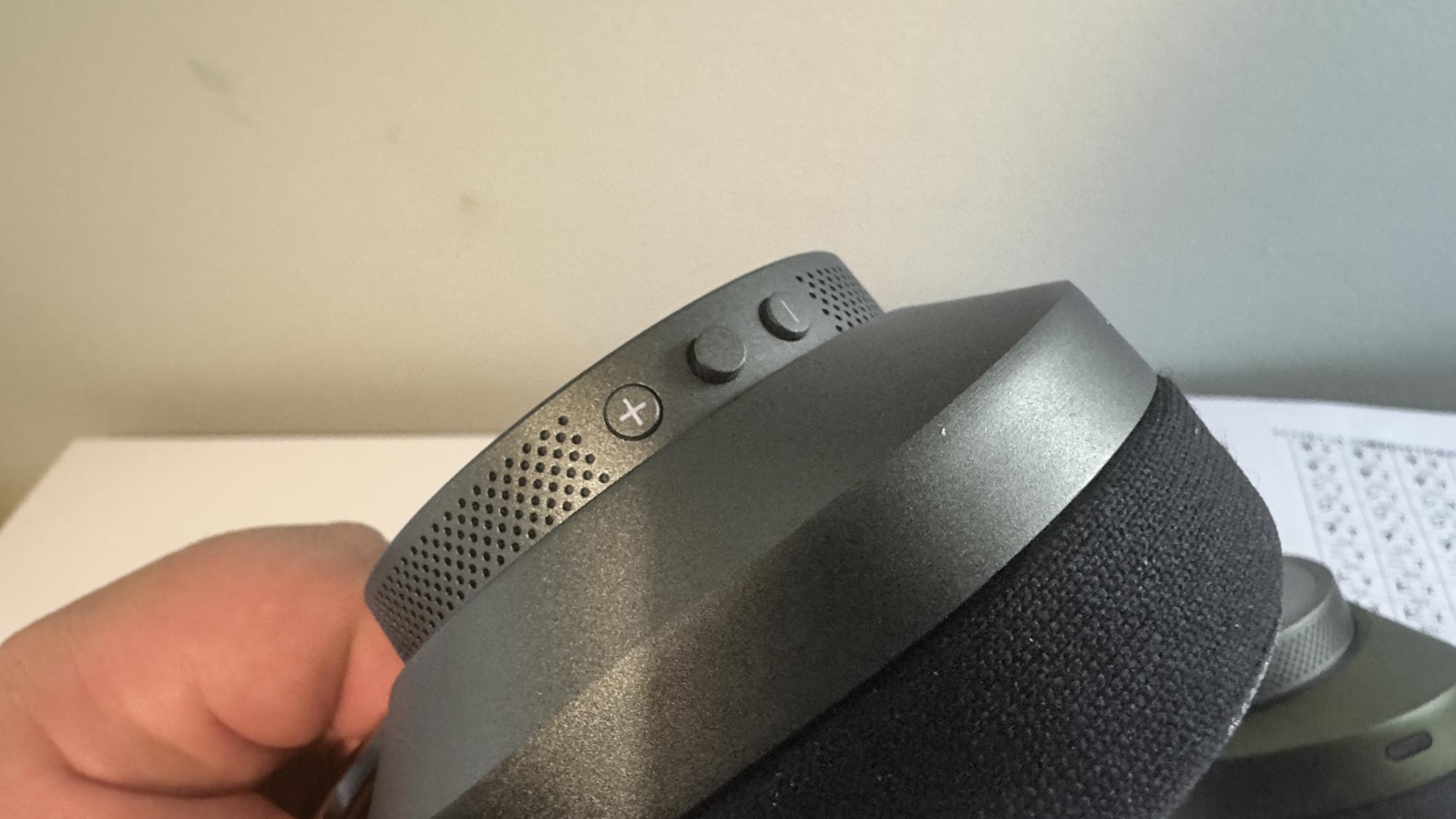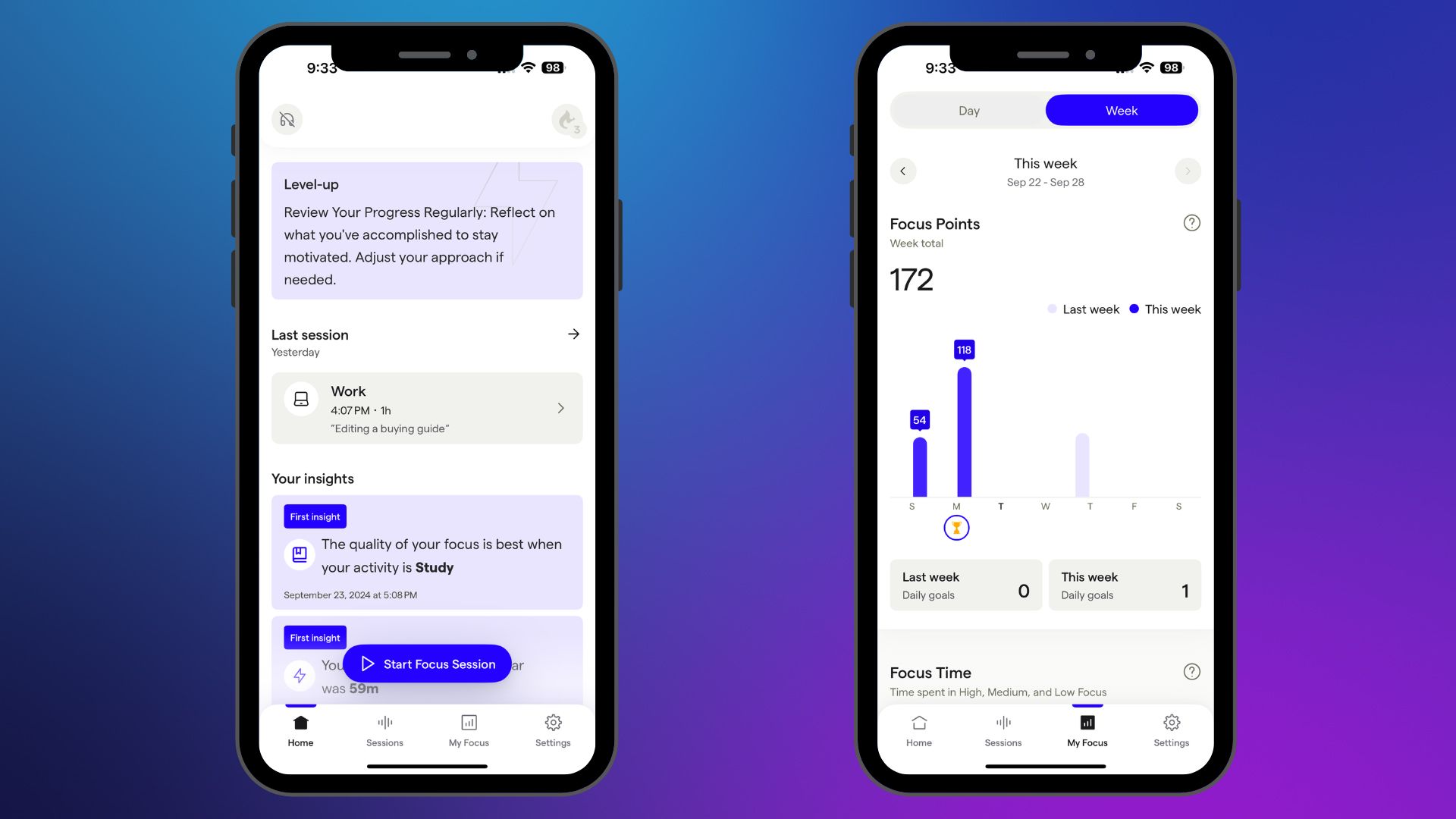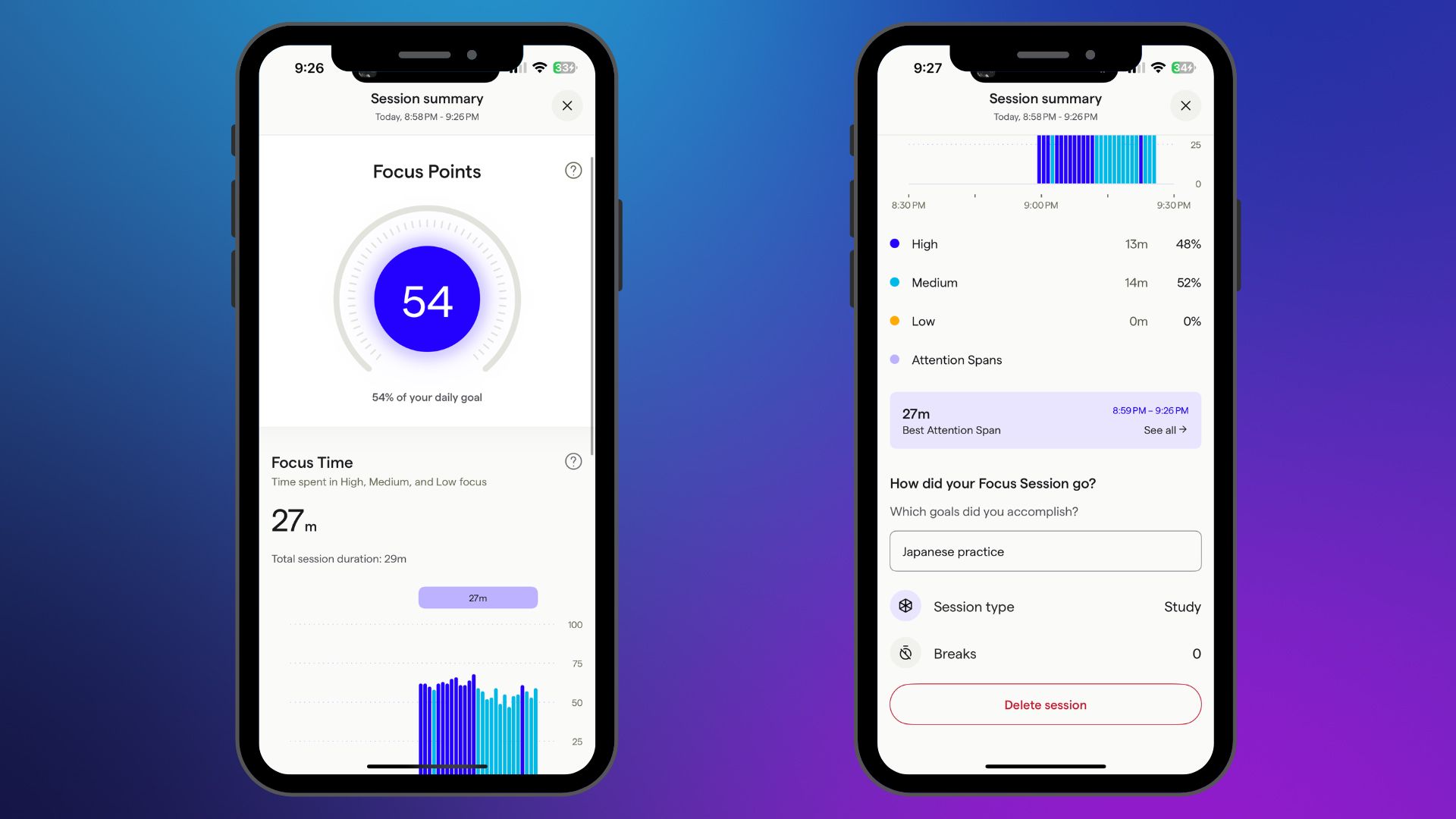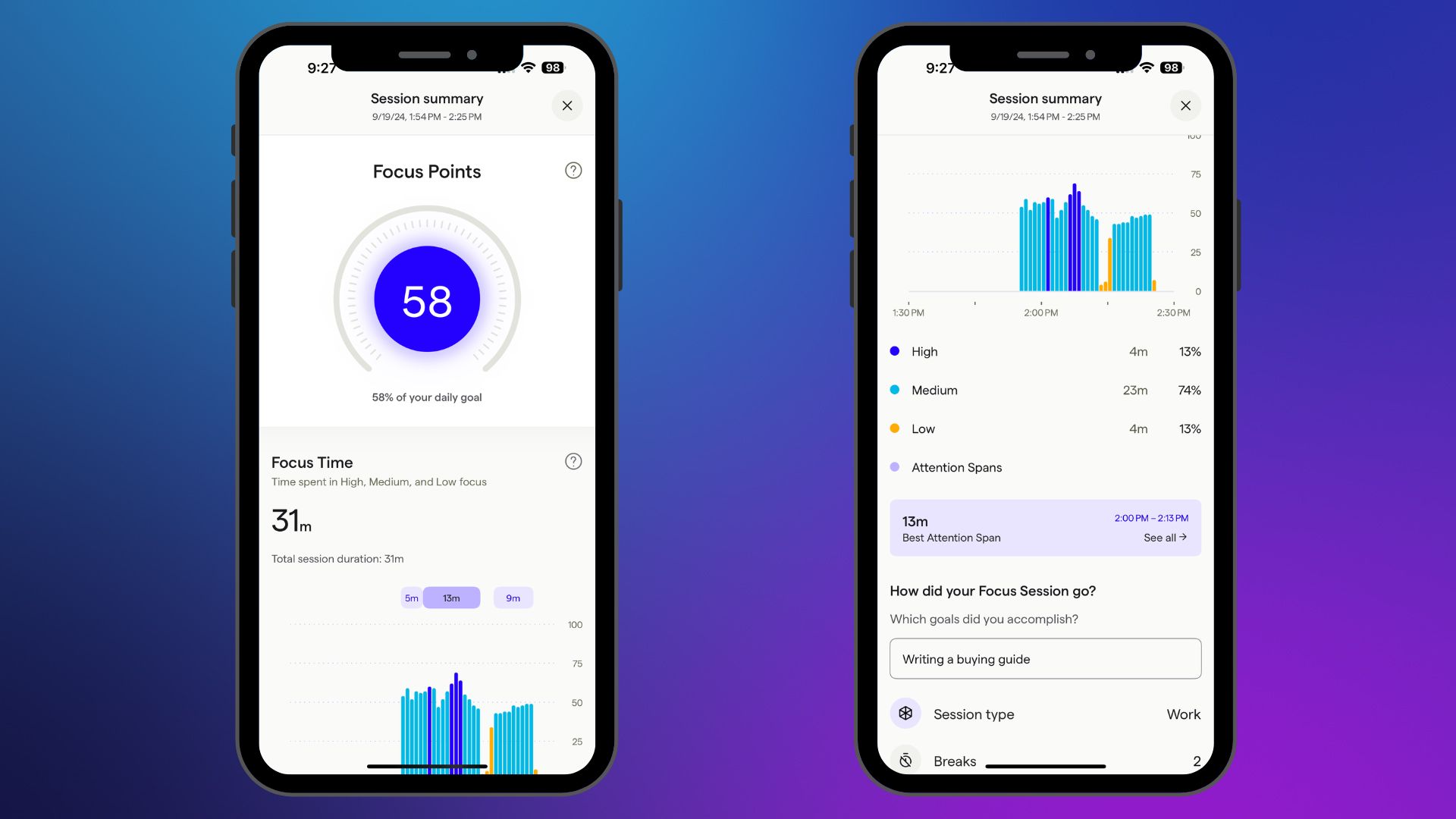Tom's Guide Verdict
The MW75 are already a very solid (if expensive) pair of headphones, and the Neurable edition add in some very clever extra smarts. They’re not cheap, but the insights into your focus and concentration are at least interesting.
Pros
- +
Built on an excellent pair of headphones
- +
Interesting insights into your focus
- +
Physical music controls
Cons
- -
Expensive
- -
New touch panel sometimes needs two fingers
- -
Smart features usefulness remains to be seen
Why you can trust Tom's Guide
Anyone who’s spent more than 30 minutes with me knows that I have problems concentrating on just about anything. I could be doing the most important writing of my life, and I’ll spot something out of the corner of my eye that draws my attention away like an excited dog that’s just spotted a squirrel.
Just writing this my eyes have been averted three separate times (and I have counted) to different outside influences, from a bird that got particularly close to my window to a funny noise that made it through my headphones noise canceling. (if you’re wondering, it was someone making a coffee on the other side of the house — they dropped their mug on their foot).
Enter the Master & Dynamic MW75 Neuro, a pair of smart wireless headphones that use sensors that look inside my skull at my brain, and a very clever app to map out my concentration level. While this is a headphone review, there’s more to look at than just sound quality and comfort.
Master & Dynamic MW75 Neuro review: Cheat sheet
- What is it? A very clever pair of smart headphones which use brain sensors and AI to map out your focus level, and avoid burnout while you work, study or even exercise.
- Who is it for? People interested in improving focus or finding out when it’s best to take a break.
- What does it cost? $699/€729/£629/AU$1,020
- What do we like? A fascinating look at how your brain works, and how you focus. A great proof of concept for further uses of the technology.
- What don’t we like? They are very expensive, and perhaps out of reach of people who might find the smart features useful.
Master & Dynamic MW75 Neuro review: Price and availability
There are two places you can get hold of a pair of M&D MW75 Neuro — the Neurable website, where you can find the Silver, Onyx, Navy, and Olive color options. You can also find a pair on the Master & Dynamic website, although you’ll only find the Silver and Onyx colorways there.
Price-wise, you’re looking at a costly pair of headphones. In the US, the price is $699, which is $100 more than the standard MW75. They are a premium device that deserves a premium price, but that is a lot of money to pay for anything, let alone a pair of wireless headphones. In the UK and EU they’ll be available come early 2025, and you’ll find them for £629 and €729 respectively. Again, they’ll be available on the Master & Dynamic and Neurable websites.
Comparing them to the competition in this regard is tricky — yes, you could pick up some AirPods Max for $200 less, but then you’re missing out on the smarts that come with this pair of headphones. There’s really nothing out there like the MW75 Neuro, but given they’re so expensive, it’s the extra smart features, the focus reading and the Neurable app that need to justify the premium.
Master & Dynamic MW75 Neuro review: Design and build

- Comfortable fit
- Beautiful, metal and leather build
- Unobtrusive brain sensors
The headphones that the MW75 Neuro are built on, the Master & Dynamics MW75, are a stunning pair of headphones to begin with. They're wrapped from top to bottom in sumptuous leather, and built out of a mixture of aluminum and stainless steel. They feel every bit worth that high asking price, with some of the most premium materials you’ll find this far north of the AirPods Max.
The earcups are milled out of aluminum, and then coated in their color — in this case, a fetching Olive Green. The sides of the earcups feature a glass panel that shines, polished in the light, giving them a premium look and feel.
The headband, while thin, is wrapped in lambskin leather for a more expensive, luxurious feel, and it does a great job of spreading the not-inconsiderable weight of the headset across the top of your head.
The earpads are the thing here that differs most from the standard model of the MW75, as they’re made out of cloth instead of leather. That makes them slightly rougher to the touch compared to the smooth leather finish, but it doesn’t diminish their otherwise extremely comfortable fit.

It all adds up to a very attractive pair of headphones that wouldn’t look out of place on the seat of a Rolls Royce, or a Lamborghini sports car. They look and feel every bit as luxurious as the price would demand, and you never feel like they’re not worth the price you pay for admission. But that’s not all there is to the MW75 Neuro — far from it.
The earpads, you’ll notice are stripy. This isn’t just a visual design decision, although it does look pretty funky, but rather a necessary one to house the brain sensors that bring the Neurable smarts. Considering these kinds of sensors normally require a kind of mad-scientist-looking head cap to read your brain waves, it’s extremely impressive that Neurable has been able to pack them into the earpads of an already existing pair of headphones.
Speaking to Dr. Ramses Alcaide, the co-founder and CEO of Neurable, a lot of effort was put into making sure that the Neurable tech was as noninvasive as possible, not getting in the way of the headphones being a pair of headphones. Interestingly, it's a surprisingly small addition to the headphones so there wasn’t much that needed to be done to make it fit. There's just the sensors, a conductive interface between the earpads and the headphones, and then a Neurable chip inside that gathers all the data for the Neurable app.
You’re left with a very smart set of extremely well-built headphones that don’t suffer as a result of their smart tech. The only thing that tells other people you have a pair of smart headphones is the Neurable logo on the side of the headband, and some text on the left earcup — otherwise, you’ve just got a fancy colorway of the MW75s.
Master & Dynamic MW75 Neuro review: Controls

- Solid physical controls
- The touch controls are touch-and-go
Now, I love some physical controls, and while they’re small, the physical controls on the MW75 Neuro are good. There’s a power button and ANC button on the left earcup, and while they’re a little small, it’s easy to remember which is which. On the other earcup you’ll find a play/pause button, and skip forward and back. There’s wear detection as well, and it works well, pausing when you pull them off and playing when you put them back on.
There are also some touch controls for the Neurable function on the left earcup, and they’re a little more tetchy. Press once to pause a session, and then hold to end one. Frequently, I had to use two fingers for a press to register which is a shame — although they’re hard to press accidentally as a result.
Master & Dynamic MW75 Neuro review: Features
- Great, premium feature set
- DAC mode is a great bonus

Let’s get the expected ANC headphones features out of the way first. The Master & Dynamic MW75 Neuro have ANC, and it's very good. It blocks out plenty of noise, although it doesn’t quite reach the lofty heights of the Sony WH-1000XM5 or the AirPods Max. Transparency mode is present and correct, and it works well.
I noticed a slight crackle when noise canceling or transparency was activated — I reached out to Neurable as to whether that’s an issue with just my headset. The company responded and says that there was an ANC mode bug that has been resolved with a firmware update. So hopefully users won't experience this issue.
Bluetooth codec support is good on the MW75 Neuro, including AAC, aptX adaptive, and SBC. There’s Bluetooth 5.2 on board, so you’ll get multi-device connection on launch, and it’s been stable and stutter-free throughout my testing of the headphones. You can connect your MW75 to the Master & Dynamic Connect app as well, where they act like a normal pair of MW75s, so you can change their EQ, activate noise canceling, and more. There’s a USB-C DAC mode, too, so you can use the internal DAC to get higher-quality listening if you plug them into your iPhone, Android handset, MacBook or compatible PC.
Finally, you get a very nice hard carrying case in the box to protect your headphones, which is always a nice bonus to get — if not an expected one, given the price.
Master & Dynamic MW75 Neuro review: Reading your brain

Now — on to the fun stuff. At the core of the Neurable experience is the Neurable app (which, at the time of writing is only available on iOS — although I’m told it will be available for Android on launch). Those brain sensors in the cushions of the headphones are used by the app to read your brain activity, and from there, it gauges whether you’re concentrating or focusing on something or not. I saw this happen in real-time, watching Dr. Ramses' concentration go up in real time as he focused on some text in front of him, and then watched it fall as he turned back to talk to me.
It’s a remarkable thing to see, and gives you a picture of what your brain is doing while you work, study, listen to music, read, and more. In the app, it’s used to measure your concentration while you do a set task, giving you a score readout at the end divided up into high focus, medium focus, and low focus — the higher the focus for a period of time, the more points you get.
Still with me? Great. After a quick setup, you open the app and choose "Start a session" — then the brain monitoring begins. There’s nothing you need do while it's working; it gets reading in the background while you do your task. There’s not much to see on screen while it does its work — only a pause button, an end button and a timer that tells you how long you’ve been going.

Once you’ve finished your session, you’re given a score, made up of all the moments you concentrated, and then a small graph that shows you more details about the concentration levels during your session. It’s a cool thing to look at, that’s for sure, but it does leave some questions.
For my use case, as someone who struggles with concentration, how useful are these data points going to actually be? And how willing will I be later on down the line to keep doing these concentration sessions with the app and the headphones? What if I don’t want to do concentration sessions while wearing headphones? How safe are the EGG sensors that sit on your head, and how safe is it to wear them for long periods of time?
You can make that the case that the Apple Watch has sensors on your wrist measuring stuff all the time, and that on your head you wear Bluetooth devices all the time — but there’s still something slightly concerning about something bouncing waves inside your melon while you work or listen to music.
Now, on to the results themselves, and some of my results. I’ve done a couple of different tests to see what my concentration levels look like when I do different tasks. We’ll start with my language learning — I’m currently learning to speak and write Japanese, and part of that is learning the scripts. I popped the headphones on for a session of learning Katakana, and as you can see from the results, my concentration was pretty good while I wrote out the symbols over and over again, while verbalizing what they represent. What it doesn’t tell me, however, is where I should take a break, or what I was concentrating on. I was listening to music while I was practicing, or was it that or the language practice I was focussed on?

My next test was doing some work, over the span of half an hour. Again, we can see that I spend a decent amount of time concentrating on my work — although again, whether it was on my work, the music I was listening to or something around me remains to be seen. This is a limitation with the technology itself, and one that is unlikely to be worked around, but it is worth noting that it is a system that can be cheated.

For example — I could start a session that’s supposed to be concentrating on my work, and then spend the whole time focused on Twitter instead. There is some degree of keeping yourself accountable with the whole thing, that’s for sure.
The other part of the sensors and the app is that it's supposed to help you find the best times to take a break, and avoid burnout over time — and that will require you to wear the headphones for longer periods of time than you might feel comfortable with. The longest session I took with the headphones was an hour long, as I wrote another review — and despite the fact I’d already been writing for two hours, the app didn’t once tell me that I should take a break.
Now, we’ll be doing more tests with the MW75 over the next few weeks (we, alas, haven’t had loads of time to test them before release here), and we’ll make a more holistic picture of just how useful the concentration metrics actually are. As it stands at the moment, however, it seems like a nice idea that’s implemented well into the headphones — but how useful those metrics will be in measuring concentration and finding the best times to have a break remains to be seen.
Master & Dynamic MW75 Neuro review: The future

Now, there are some cool things planned for the future of the MW75 Neuro, and Dr. Ramses tells me that the sensors will be open for use by other developers. One cool use In was shown used ChatGPT to create message responses to incoming messages, which you choose using the built-in gyros and brain sensors to automatically send back to your friends with a nod to the left or right.
It’s that developer involvement that could be the most exciting part of the Neurable headphones — although we’ll have to see what’s coming.
Master & Dynamic MW75 Neuro review: Sound Quality

- Solid hifi sound
- The high-range is slightly reduced
While the smart stuff is the key feature, they are still a pair of wireless headphones — and they still have to sound good to get any kind of recommendation from me. Thankfully, just like their MW75 compatriots, these headphones sound great, and they're easily amongst the best noise-canceling headphones.
There’s some great bass response here, and the highs are nice and crisp to boot. The soundstage is a little restricted, unfortunately, but their ability to reproduce some great audio remains from the non-Neurable version — the addition of those sensors has not done anything untoward to the sound quality of the headphones.
Meatloaf’s Bat Out of Hell is a blast no matter what you use to blast it at full volume, but the warmth of the MW75 Neuro do it perfect justice. The kick drums are impactful and deep, and the piano is smooth and supple. There’s a little lacking in the upper registers of the track, but you’ll not worry as you’re wrapped in the crooning vocals of Meatloaf himself as he croons to you behind his microphone.
Le Sserafim’s CRAZY gets you bouncing with a pulsating bassline, and the MW75 keep up with surprising dynamism. You won’t be missing any of those highs, as the mid-punch brings the girl's vocals to the forefront. All the girls are, indeed, girling.
Master & Dynamic MW75 Neuro review: Noise cancellation
- Reduces noise well, although there are better
- You might expect more for the price
The noise canceling on the MW75 was never anything to write home about, rather being adequate. It’ll block out the noise from a loud office environment, and make taking the train to and from work a whole lot more tolerable — as long as you don’t mind wearing $700 headphones surrounded by potentially greedy fingers. It’s not as good as that you’ll find on the AirPods Max or the Sony WH-1000XM5, unfortunately, which is a shame, especially considering how much they cost.
The adaptive ambient mode is supposed to adjust itself according to the noise around you, and it does a solid job of choosing the right sounds that you might actually want to hear. It’s not perfect, but then very few adaptive noise-canceling modes are. It makes talking to a bus driver or a store clerk much easier, which is kind of the point — although for $700 you might hope for more.
Master & Dynamic MW75 Neuro review: Call quality and connectivity
- Crisp microphone
- No voice isolation
Calling quality from the MW75 Neuro was also solid based on my testing, with my recipients commenting on how good the microphone sounded. It became harder to hear me when there were noises around me, unfortunately, so they’re not up there with the likes of the AirPods Pro 2, but they’re otherwise a perfectly serviceable pair of headphones to call people on.
Master & Dynamic MW75 Neuro review: Verdict
This is a tricky one — as a pair of headphones, the MW75 Neuro are very good. They are built like a luxury piece of furniture, with some of the most premium materials around in the construction. They sound good, they’re comfortable and they do at least feel like they’re worth the high price.
The thing is, you can buy the MW75 without the Neurable features, and get all those good things for $100 less. Then it becomes a question as to how useful the data is to you, and whether they actually manage to tell you to take a break when your brain needs it — and while it’s cool to look at, at this stage it doesn't feel fully baked. Honestly? Unless you really need or have a great interest in looking at how your concentration changes, you’re better off buying the non-Neurable version for now until the app becomes even smarter and the company unlocks more of its smart potential.
More from Tom's Guide

Tammy and her generous collection of headphones have found a new home — Tom's Guide! After a two-and-a-half-year stint as iMore's resident audiophile, Tammy's reviews and buying guide expertise have more focus than ever on Tom's Guide, helping buyers find the audio gear that works best for them. Tammy has worked with some of the most desirable audio brands on the planet in her time writing about headphones, speakers, and more, bringing a consumer focussed approach to critique and buying advice. Away from her desk, you'll probably find her in the countryside writing (extremely bad) poetry, or putting her screenwriting Masters to good use creating screenplays that'll never see the light of day.

